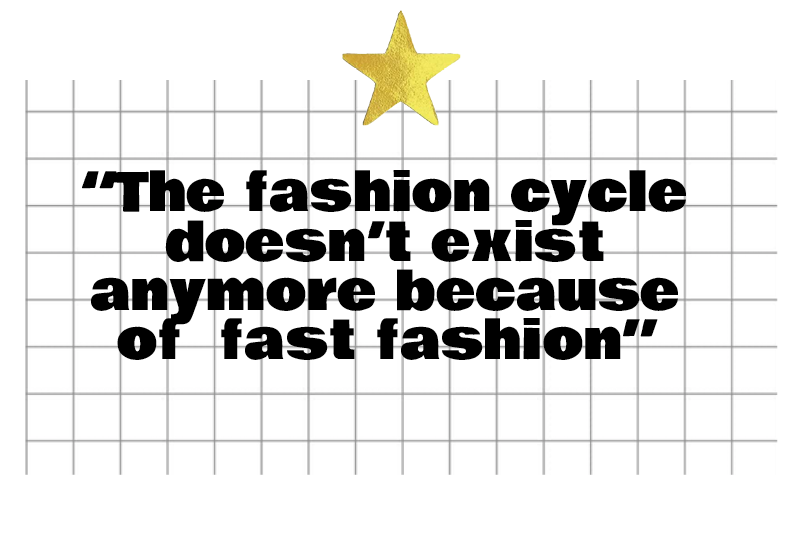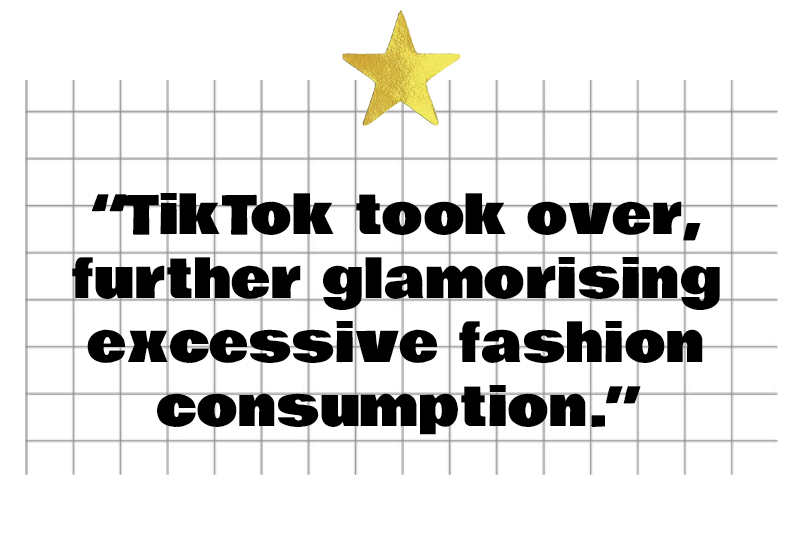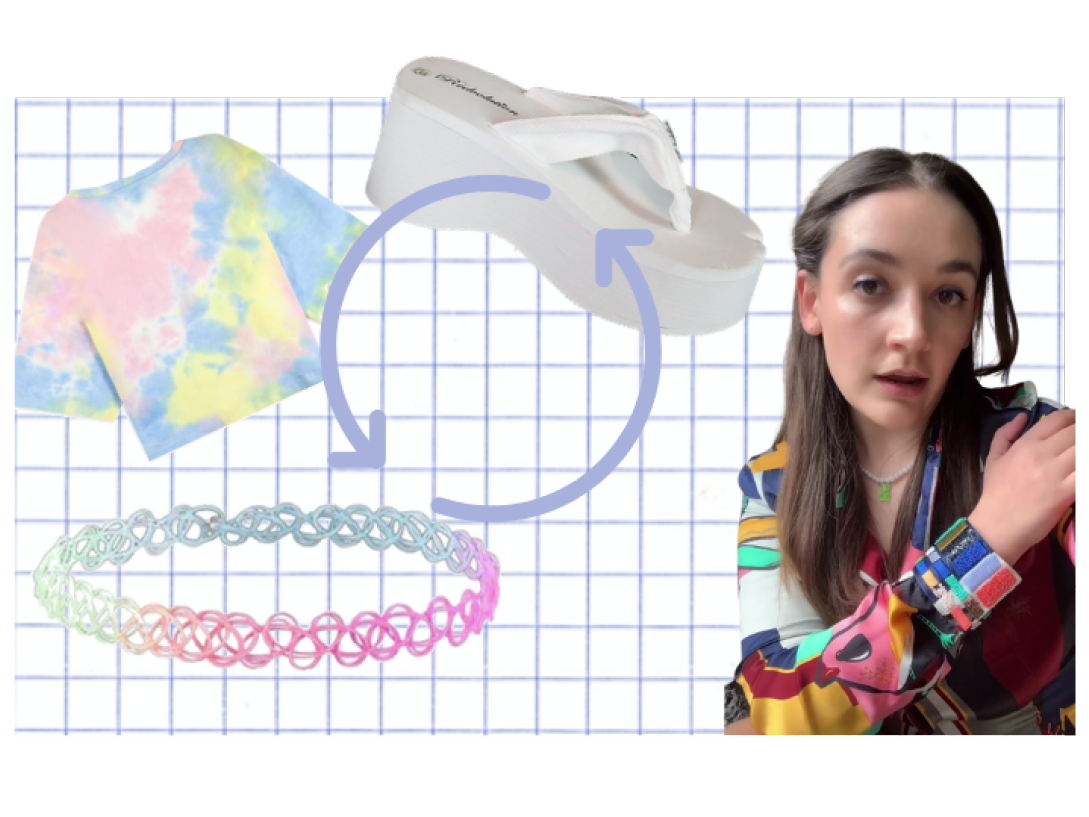Do you remember a few years ago we saw the rebirth of 90s plastic chokers, chunky platform trainers and pastel crop tops?
The 90s-00s trend came back from a 20-year hibernation to cycle once more into our fashion aesthetic. Just before it, came the 80s’ puffed-up shoulders and the psychedelic tie-dye and XXL collars from the post-Woodstock era.
Many people are saying that this trend cycle is accelerating like never before, inducing much more turnover of merchandise – with an ever-increasing environmental impact. For instance, British online fast fashion retailer Boohoo’s business model is based on getting new trends out quickly. Younger consumers’ demands for those inexpensive Boohoo’s clothing items made the sales climb by 41% to £1.7bn in a year.
That is a problem when we remember the fast fashion industry is the second largest polluter of the environment on the planet. To produce a kilo of cotton fabric, 20,000 litres of water is needed. And dyeing a tonne of this material, which is almost mandatory, requires 200 tonnes of fresh water. I’ll let you do the maths.
But is it true that new trends are being born at a higher rate than before?
For Barbara Vinken, German professor and author of the book Fashion Zeitgeist, there is a “kind of vintage cycle” that appears once an item feels forgotten and is translated into a different context. She cites Olivier Saillard, a French fashion historian who thinks it takes around five to eight years for silhouettes and aesthetics to really change. Vinken explains: “It is when the waist switches down, switches up, whether the pants are tied, or widened, how the shoulder should look…”
These evolutions were introduced by high fashion designers during their collection presentations at fashion weeks. Obviously, some trends were also created by subcultures and outcast groups, such as the sneakers without laces which came from prisoners or the skater’s slip-on shoes. But for Vinken “it’s the designers who could give those trends the format it needs to be popularised.”

Vinken says most of the fashion trends used to be structured by the fashion shows of Spring/Summer and Autumn/Winter. Now, there are at least four collections: the Resort/Cruise collection in spring and the Pre-Fall collection in winter. Thus, the designers and the producers have much more to do and there is much more to be sold. But Vinken explains: “The problem with the fashion cycle is that it probably doesn’t exist anymore because fast fashion completely disrupted this kind of rhythm.”
In the fast fashion system, new collections come into shops every four to five weeks and this quick turnover profoundly modified the rhythm of classical fashion cycles.
Mandy Lee, a 29-year-old TikTok creator who studied trend forecasting, spoke to Stitch Up! about this acceleration of the fashion trend cycle. She explains that it is “capitalism’s dream state to have as many trends accelerating as quickly as possible” because once a trend is dictated as dead, people move on to the next thing. Then this process accelerates, it causes more sales volume and thus more financial income.
Lee also talks about the microtrend concept, which is a trend that follows the same pattern without having an impact on the overall fashion trend cycle. It can be a singular item or an easily recognisable set of items, which has a huge rise and fall very quickly. For instance, she identifies the ‘coconut girl’ microtrend which is inspired by the 2000’s beach aesthetic: large-scale floral print, pastel crochet, and easy silhouettes. Brands are producing more to answer that microtrend, but Lee recommends thrifting for those items.
However, Lee refuses to blame everything on fast fashion brands. For her, social media and the way we consume those have a part of the blame. Over time media content got shorter: long-form articles transformed into Facebook and Instagram posts. But when TikTok arrived, creating a non-stop video channel, people started consuming 100 videos in the same amount of time as one YouTube video.
“The nature of the shortened content that we see and that we’ve got accustomed to seeing is just content overload,” says Lee, adding, “As we’re just seeing many more things in a short amount of time, we make these associations in our head where it’s like ‘I’ve seen this item 50 times, or 100 times and I’m conditioned to see it.’”

In addition, she explains that we have normalised overconsumption in video content. It first started on YouTube, with the clothing hauls trend where people would buy a bunch of clothes to film themselves trying on, as a form of entertainment. TikTok then took over that video trend, further glamorising excessive fashion consumption.
Nowadays, brands use influencer marketing strategies where they gift clothing and pay influencers to post themselves wearing that specific item over a decided time window. This generally happens during a week-long period which allows the item to appear several times on people’s social media feeds.
Mandy Lee thinks this also feeds into trends moving faster: “It’s just a combination of things: brand-spanking new influencer marketing strategies, the influencers complying with this. It’s content consumers, the people who are just watching media, allowing themselves to be influenced by it.”
So how can we slow this accelerating fashion cycle?
For Barbara Vinken, it’s the consumer culture that must change. In the past, people used to spend much more money on clothes than today. “People must get more quality conscious, buy more locally to end that mass fashion production.”
For Lee, every individual has the ability to choose once they realise the way the trend cycle works and the way influencers and social media are marketing to them: “You have to start noticing the decisions you make when you’re purchasing things.”
People will then have more conviction in their purchases and not blindly buy every single trend that comes on the market.
Lee found herself stuck in the fashion cycle at the end of last year and felt as if she was overconsuming for two months. It damaged her imagination and the way she chooses to get dressed, so she decided to begin a no-buy period of three months.
“Now I have a totally new appreciation of the clothes that I already have, and I’m so not tempted to go out and buy any of these trends right now.” She adds, “I don’t think that’s going to work for everybody, but I think that’s a really good tip to just stop consuming and play with the clothes that you already have and see what you naturally gravitate towards.”
However, for Lee, if you like a trend, you should make it your own. And that doesn’t necessarily mean buying that specific new item, secondhand is an option, making it yourself is another. If you decide that you love a particular item, you can style it in many different ways, if it works for your lifestyle then the item in question will have inherently more longevity, and that’s a huge step in the right direction.
For more on how you can resist the trend cycle, read our interview with a fashion psychologist.

